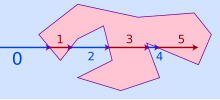Point in polygon

In computational geometry, the point-in-polygon (PIP) problem asks whether a given point in the plane lies inside, outside, or on the boundary of a polygon. It is a special case of point location problems and finds applications in areas that deal with processing geometrical data, such as computer graphics, computer vision, geographic information systems (GIS), motion planning, and computer-aided design (CAD).
An early description of the problem in computer graphics shows two common approaches (ray casting and angle summation) in use as early as 1974.[1]
An attempt of computer graphics veterans to trace the history of the problem and some tricks for its solution can be found in an issue of the Ray Tracing News.[2]
Ray casting algorithm

One simple way of finding whether the point is inside or outside a
This algorithm is sometimes also known as the crossing number algorithm or the even–odd rule algorithm, and was known as early as 1962.[3] The algorithm is based on a simple observation that if a point moves along a ray from infinity to the probe point and if it crosses the boundary of a polygon, possibly several times, then it alternately goes from the outside to inside, then from the inside to the outside, etc. As a result, after every two "border crossings" the moving point goes outside. This observation may be mathematically proved using the Jordan curve theorem.
Limited precision
If implemented on a computer with
Most implementations of the ray casting algorithm consecutively check intersections of a ray with all sides of the polygon in turn. In this case the following problem must be addressed. If the ray passes exactly through a vertex of a polygon, then it will intersect 2 segments at their endpoints. While it is OK for the case of the topmost vertex in the example or the vertex between crossing 4 and 5, the case of the rightmost vertex (in the example) requires that we count one intersection for the algorithm to work correctly. A similar problem arises with horizontal segments that happen to fall on the ray. The issue is solved as follows: If the intersection point is a vertex of a tested polygon side, then the intersection counts only if the other vertex of the side lies below the ray. This is effectively equivalent to considering vertices on the ray as lying slightly above the ray.
Once again, the case of the ray passing through a vertex may pose numerical problems in
Winding number algorithm
Another technique used to check if a point is inside a polygon is to compute the given point's winding number with respect to the polygon. If the winding number is non-zero, the point lies inside the polygon. This algorithm is sometimes also known as the nonzero-rule algorithm.
One way to compute the winding number is to sum up the angles subtended by each side of the polygon.[4] However, this involves costly inverse trigonometric functions, which generally makes this algorithm performance-inefficient (slower) compared to the ray casting algorithm. Luckily, these inverse trigonometric functions do not need to be computed. Since the result, the sum of all angles, can add up to 0 or (or multiples of ) only, it is sufficient to track through which quadrants the polygon winds,[5] as it turns around the test point, which makes the winding number algorithm comparable in speed to counting the boundary crossings.

An improved algorithm to calculate the winding number was developed by Dan Sunday in 2001.[6] It does not use angles in calculations, nor any trigonometry, and functions exactly the same as the ray casting algorithms described above. Sunday's algorithm works by considering an infinite horizontal ray cast from the point being checked. Whenever that ray crosses an edge of the polygon, Juan Pineda's edge crossing algorithm (1988)[7] is used to determine how the crossing will affect the winding number. As Sunday describes it, if the edge crosses the ray going "upwards", the winding number is incremented; if it crosses the ray "downwards", the number is decremented. Sunday's algorithm gives the correct answer for nonsimple polygons, whereas the boundary crossing algorithm fails in this case.[6]
Implementations
SVG
Similar methods are used in
nonzero or evenodd. For example, in a pentagram, there is a central "hole" (visible background) with evenodd, and none with nonzero attribute.[9]For
Point in polygon queries
The point in polygon problem may be considered in the general repeated
Special cases
This section needs expansion. You can help by adding to it. (August 2013) |
Simpler algorithms are possible for monotone polygons, star-shaped polygons, convex polygons and triangles.
The triangle case can be solved easily by use of a barycentric coordinate system, parametric equation or dot product.[11] The dot product method extends naturally to any convex polygon.
References
- ^ Ivan Sutherland et al.,"A Characterization of Ten Hidden-Surface Algorithms" 1974, ACM Computing Surveys vol. 6 no. 1.
- ^ "Point in Polygon, One More Time..." Archived 2018-05-24 at the Wayback Machine, Ray Tracing News, vol. 3 no. 4, October 1, 1990.
- ^ Shimrat, M., "Algorithm 112: Position of point relative to polygon" 1962, Communications of the ACM Volume 5 Issue 8, Aug. 1962. https://dl.acm.org/doi/10.1145/368637.368653
- .
- ISBN 0-12-336155-9
- ^ a b Sunday, Dan (2001). "Inclusion of a Point in a Polygon". Archived from the original on 26 January 2013.
- ^ Pineda, Juan (August 1988). A Parallel Algorithm for Polygon Rasterization (PDF). SIGGRAPH'88. Computer Graphics. Vol. 22, no. 4. Atlanta. Retrieved 8 August 2021.
- ^ "Painting: Filling, Stroking, Colors and Paint Servers – SVG Tiny 1.2". www.w3.org. Retrieved 2021-07-24.
- ^ "Painting: Filling, Stroking, Colors and Paint Servers – SVG Tiny 1.2". www.w3.org. Retrieved 2021-07-24.
- ^ Michael Galetzka, Patrick Glauner (2017). A Simple and Correct Even-Odd Algorithm for the Point-in-Polygon Problem for Complex Polygons. Proceedings of the 12th International Joint Conference on Computer Vision, Imaging and Computer Graphics Theory and Applications (VISIGRAPP 2017), Volume 1: GRAPP.
- ^ Accurate point in triangle test "...the most famous methods to solve it"
See also
- Java Topology Suite (JTS)
- Discussion: http://www.ics.uci.edu/~eppstein/161/960307.html
- Winding number versus crossing number methods: http://geomalgorithms.com/a03-_inclusion.html

